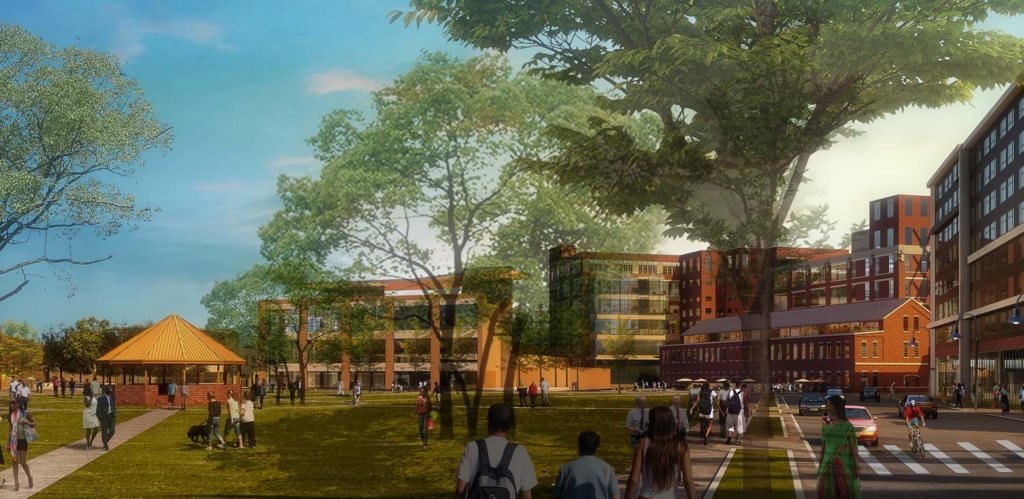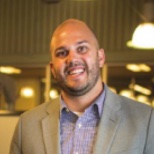We want to open their minds to different experiences. What does it mean to be curious about the possibilities and how can you put your skills into action? That is the question we want to enable kids to grapple with.
Riley Johnson, Amp Lab
We sat down with Riley Johnson who is leading an effort in Fort Wayne, Indiana to launch programs in partnership with the local school district, Boys & Girls Club, and a local career pathway center.
Q: Why create Amp Lab and what will it offer learners in your community?
Riley: Amp Lab stems from both my professional and my personal desires. I have always loved transformation in schools, but in my lived experiences of almost three decades in education, there’s always kind of a cap on what is possible.
When you think of the progressive ability of a school to really transform, I feel like you see amazing things but it’s always still school. So for me, it was like, how do we design backward? How can we create something where we’re still in the realm of public education and embedded in the school day experience, but it looks, sounds, and feels nothing like that? How do we rip apart the barriers of school from the inside, without feeling like we have to dismantle it completely?
That is what we have been trying to create at both the high school and middle school level for learners in Fort Wayne. We’re excited to be launching in August 2022.
The high school program is going to be hosted at Electric Works, an old General Electric factory. I think it’s roughly a 1.5 million square foot, 12-acre campus right in the heart of downtown Fort Wayne that’s been vacant since the late eighties.
In the last five years, the community got behind the idea of turning the space into a mixed-use campus. Essentially you’ve got the marriage of businesses, social services, retail, entrepreneurs, food, and the education sector coming together into this one campus. The school district was one of the first to say we’re going to be a part of it.
Using that facility, we will open this fall and will have 400 juniors and seniors come to spend either a year or two years here for a half-day program. They’re still full-time students at their home school. We will pull from five high schools in the area, which we are excited about. We hope it is a playground to what comes next for learners.
At the middle school level, we are trying to leverage the ecosystem mentality. We have a very functional Boys and Girls Club that is already an amazing part of our community but sits empty during the school day. They are launching a new facility called the Jim Kelley Career Pathway Center. The Amp Lab team will bring middle schoolers into the space to explore who they are, be exposed to career pathways, and engage with immersive tools and equipment. We hope this will be a really meaningful, almost capstone-like experience, for 8th graders at 12 middle schools in our community.
Both the high school and middle school programs will partner with industry leaders, community organizations, and nonprofits. All of this came to be because we had some prominent organizations, industry, and philanthropists in the community saying we support it and want to make it happen.
Q: What was it like to get this work going, particularly when it came to enabling work across the district and community partners?
Riley: Our current superintendent did a really good job of setting the stage. Last year was his first year, and even in COVID chaos, one of the primary goals of our district moving forward was going to be creating human capital pipelines back into the community.
Fortunately, the Boys & Girls Club and many partners in the community were the ones asking for this type of experience and opportunity. There also was a pre-existing, longstanding relationship between the Boys and Girls Club and the district, and the energy between our superintendent and their organization was really positive. Therefore, there was almost immediate alignment and synergy; they knew they wanted to build this new venture together.
I got involved as the Director of Amp Lab because I worked in Fort Wayne Community Schools and knew we needed to expand our options for young people.
When we started, we knew the Boys and Girls Club already shares a lot of their students with the district, and we wanted to see what it would take to get all 2,000+ 8th graders through the door. In the long run, this would be a win-win because more Fort Wayne students would be connected to the club and be exposed to career pathways at the same time.
Once we knew we wanted to work together, we wanted to make sure that we were honoring the goals of the Boys and Girls Club, while also bringing our voice to the table as co-designers. It was important to both of us that the experience we offer to kids be more holistic than what either one of us could offer independently. We also knew the Boys and Girls Club was really good at offering unique experiences to kids from marginalized communities, and we, as the district, wanted to leverage and learn from that.
How can we create something where we’re still in the realm of public education and embedded in the school day experience, but it looks, sounds, and feels nothing like that?
Riley Johnson, Amp Lab
Q: How will Amp Lab, and what it will offer, change the experience for learners in Fort Wayne?
Riley: It will change the possibilities of what can happen and what learners experience throughout the school year, both before and after their experience with Amb Lab.
During middle school, it’s really about exposure. How do we create an opportunity for those middle schoolers to have an immersive experience with a variety of pipelines to industry?
We are also trying to do this without it being overly concrete or prescriptive. We don’t want to set it up so eighth-graders are having to choose to go down a pathway to become an entrepreneur, or a lawyer, or a mechanic. We want to open their minds to different experiences. What does it mean to be curious about the possibilities and how can you put your skills into action? That is the question we want to enable kids to grapple with.
I see a lot of really great programs that are focused on specific careers and pathways but require learners to choose one pathway. At Amp Lab, we want to be as industry agnostic and post-secondary agnostic as we can. We aren’t funneling kids to one option after they leave us; we just hope their experience exposes them to lots of options and helps them find their right path.
The last thing I’ll say to that is that I’m a big believer that nothing’s really new, there aren’t purely new ideas. Ideas just come together with new pieces and in new contexts. This is why throughout this work, we’ve asked ourselves, “How do we take elements from places we’ve experienced that we love and integrate them?”
We’ve looked at what’s happening in Kansas City and at Iowa BIG with client-connected projects; at how we can weave in lean startup and business model canvas principles; and at how we can ensure human-centered design is at the core of our processes.
We’ve tried to take what we know is really good for teenagers and add elements and components that come from both industry and human growth, in general—weaving them all together into really organic experiences. Blending these ideas and being open and flexible to shifting will change the learner experience in big ways.
Our partnership model is about “building the bridge to everywhere.”
Riley Johnson, Amp Lab
Q: How are you working with partners to understand the vision for Amp Lab?
Riley: In our preparation and planning phase, we’ve come to the table with partners saying: If you want to play with us, you’re playing with everybody. As a community, we had to get really clear on what we wanted for these kids and how our work at Amp Lab could help deliver on that.
We also came into this wanting a partnership that was meaningful for all stakeholders involved because it is always a two-way street. Some partners want to engage at different levels, and that is okay, but we have tried to be really honest and clear with each other along the way. That’s been huge, setting those conditions and agreements early has been pivotal.
We’ve also decided we want to work with all partners we can. For example, our higher ed partnerships include every university in our city because we want to intentionally increase access for our students. Our partnership model is about “building the bridge to everywhere,” so the role that 16-18-year-olds play in our region gets flipped on its head. Can you tell I’m excited about this work?
We’ve got this little ecosystem growing, so my ability to involve different partners who can provide different aspects of what a learner needs is always growing. For example, I have a partner that was originally just providing mentorship to the middle schoolers; now, they want to hire our high schoolers right out of school.
And, with all of this opportunity, I’ve also found one of the hardest parts is that we can have competing interests of different partners. My goal has been to get partners all on the same page working together towards what’s best for learners.
Q: In these programs, how will learners be supported to identify and pursue their unique interests?
Riley: We know kids are coming in with very different skills and interests, and we want to focus on supporting them from where they are—to help them find the intersection of interest and opportunity.
A kid may think they want to be a psychologist. What does it look like to bring that interest to a problem with the manufacturing company they are working with? The idea of being a psychologist in that environment in that industry might be eye-opening and reveal more to them about their own interests.
We are going to be intentionally set up to dedicate human capital to follow kids, ensuring they receive a lot of support and feedback as they discover or deepen their interests.
We have plans to use some form of portfolio model to capture growth and enable young people to demonstrate their ability and mastery. We’re also going to set up a practice of having kids provide more formal learning defenses, where they tell us more about what they learned. Because Indiana isn’t fully competency-based yet, we are working through how this all relates to the grading system.
Q: What role will community members and partners play in providing feedback for learners?
Riley: In the high school program, our goal is that learning permeates throughout our relationships, and we will be constantly providing feedback and asking for feedback from learners and our partners. We will have an amazing credentialed staff of experts, but the input learners get from community partners and industry experts will be just as vital.
We think that is going to have a ripple effect. When we come back to this conversation in three years, that’s something we hope to see, even more input and engagement from the community and partners. We’ve got some big aspirations!
I also have to share that this is the first year of my life I’ve not been attached to kids directly in a building. I miss not having those relationships. I feel like I’m spending more time visiting the local high schools than I probably need to, but it’s because I get to be with kids. I can’t wait for them to experience what we are creating at Amp Lab and establish those deeper relationships—that’s what it is all about!

